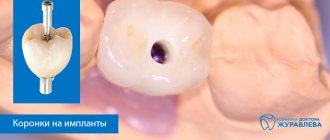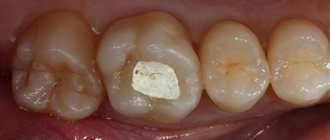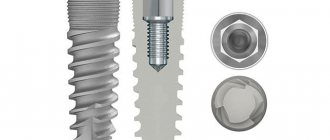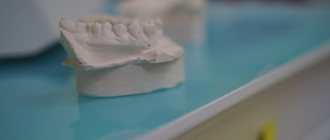According to statistics, the 6th tooth implant is installed more often than others, which is due to the characteristics of this first molar. Sixes are the first of all permanent teeth to erupt, they are used more, and therefore deteriorate faster and more often than others. The procedure for implantation above and below differs in the choice of implant and timing of prosthetics. Implantation of a six on the upper jaw takes longer - 4-6 months, on the lower jaw - 2-4 months. Osseointegration occurs with differences due to the structural features of the jaws and different bone densities. The total duration of treatment depends on the volume of bone tissue; if there is a deficiency, bone grafting or sinus lifting is performed first.
Why do sixth teeth deteriorate more often than others?
The sixth teeth (first molars according to dental classification) are molars. The rudiments are laid at the 5th month of fetal development, and at the 9th month their mineralization occurs, which continues throughout the first month after the birth of the child. Their final formation with enamel occurs only by the age of 2-3 years. Therefore, the condition of the root and crown depends on the course of pregnancy and childbirth.
Sixes do not erupt in early childhood, since the function of chewing is not yet needed. When they erupt, they do not have predecessors in the form of milk teeth, so they essentially grow from scratch. Of the permanent molars, they begin to erupt first at 5-6 years, so they last longer than others. Frequent diseases, removals and the need for implants are associated with this.
Tips from dentists for disease prevention
The development of dental pathologies can be prevented only by following the advice of qualified doctors and observing the rules of oral hygiene.
So, for prevention purposes, dentists recommend:
- do not abuse the rules of hygiene, brush your teeth only in the evening and in the morning. More frequent exposure to tooth enamel contributes to its wear;
- hygiene procedures should be carried out half an hour after eating;
- use rinses to destroy germs remaining in the mouth after brushing;
- Cleaning should be carried out for at least 3 minutes, performing circular movements.
The main rule is that if the first signs of the disease are detected, you should immediately contact your dentist. This will help prevent further development of pathology and preserve teeth.
Video: tooth anatomy
Is it worth getting an implant?
The absence of the sixth tooth threatens:
- displacement of neighboring units;
- advancement of antagonists on the opposite jaw.
Neighboring and antagonist teeth will slowly shift, which threatens to expose the roots, the appearance of wedge-shaped defects at the gum itself, exposure of the neck, which is sensitive to changes in temperature of water and food, and pain. In addition, there will be a change in the bite, since the teeth will be out of place. Therefore, it is necessary to place an implant to maintain healthy teeth and correct bite.
How many channels
The root canal system is the anatomical space inside the root of the tooth. It consists of a coronal space connected to one or more main canals at the root of the tooth.
Features of the number of channels:
- The upper and lower organs may have some differences. Usually in the area of the incisors and canines of the upper jaw there is one canal;
- The central ones of the lower row may have two recesses. But in almost 70% there is only one, and in the remaining 30% there are two;
- In the area of the second incisor of the lower jaw, in almost 50% of cases in adults there are two canals, in 6% of situations the canine has only one recess, and in the rest it has similar properties to the second incisor;
- Dental unit No. 4, also called a premolar, which is at the top, has three sockets. But a three-canal fourth premolar occurs only in 6% of cases, in the rest it has one or two recesses;
- The similar fourth premolar, which is located below, has no more than two, but in most cases there is only one;
- The upper fifth premolar can have a different number of recesses. In 1% of cases there are units with three channels, in 24% - two, and in other cases there is one depression;
- The lower fifth premolar meets a single canal;
- The sixth upper organ has the same ratio of recesses - three or four;
- Below, sixes are sometimes found with two channels, in almost 60% of cases with three, and can also be with four;
- The upper and lower seventh tooth has three canals in 70% of cases, and 4 in 30% of cases.
Operation stages
The six implant is installed in the classical way, as for all other lost teeth. Includes stages:
Preparation
Identification of contraindications, assessment of bone tissue and study of its size and density. Sanitation of the oral cavity, removal of plaque, treatment of gums and adjacent teeth. The stage lasts from several days to a month.
Bone tissue augmentation
If necessary, it is carried out as a preliminary stage in case of lack of bone tissue. The operation lasts an hour. After the planted material has fused with the bone (4-5 months), the artificial roots themselves are installed.
Installation of implants
The gum is peeled off, a bed is formed in the bone, an implant is placed, a plug is fixed, and sutures are applied. On the lower jaw, the implant takes 2-4 months to take root, on the upper jaw - 4-6 months.
Temporary prosthetics
At the patient’s request, lightweight plastic removable Butterfly immediate dentures are installed, which are attached to adjacent teeth.
Permanent prosthetics
The implant is opened, the plug is removed, the gum former is fixed, and after 10-14 days the abutment is installed. Impressions are taken and crowns are installed.
The sixth tooth implant can be placed immediately after removal into the resulting socket, but with a sufficient amount of bone tissue and under the following conditions:
- a pre-planned operation with the possibility of conducting diagnostics and assessing the immediate installation of an implant;
- atraumatic removal without damaging the alveolar process;
- absence of inflammatory and purulent processes at the root.
Why is the warranty period different for the manufacturer and the clinic?
Dentists cannot give a 100% guarantee of successful implantation, since there is always some risk. Clinics provide a guarantee of only 1-2 years. While the manufacturers' warranty for the service life of implants can range from 10 years to a lifetime .
Rejection due to defective rods is rare. Most often due to the fault of the dentist or patient, which is detected very quickly - from 2 weeks to 6 months. In rare cases, rejection is possible after several years, but this is due to poor oral hygiene or deterioration of the patient’s health.
- Complete restoration of the dentition in just 4 days!
more detailsRoott Pterygoid Implants Sinus lift is no longer needed!
more details
Once and for life! Express implantation in 4 days with a permanent ReSmile prosthesis
more details
All-on-4, All-on-6, ReSmile, Zygomatic implantation We use all modern methods of dentition restoration
more details
Features of implantation of the 6th lower tooth
The six of the lower jaw bears more loads during chewing than the upper jaw. Therefore, implants are selected taking this fact into account - wide and of sufficient length. The nuances of implantation from below:
- easier to carry out than on the top;
- implants take root faster - in 2-4 months, since the jawbone is denser and anatomically higher;
- but there is a risk of damage to the trigeminal nerve if the protocol is not followed, which is complicated by numbness of the chin and lips.
If the bone is small in height, then a preliminary operation is performed to increase it. The gum is peeled off, bone material is added, and a resorbable membrane is applied to secure it. Recovery takes up to six months.
Without preliminary bone grafting, surgery is possible if the atrophy is moderate. In this case, our Center uses bone growth stimulants. They are fixed to the neck of the artificial root during its installation and trigger the processes of bone tissue regeneration. In this case, implant healing and bone tissue growth occur simultaneously.
Technique for removing a tooth from the lower jaw
- Using a dental smoother, the circular ligament surrounding the dental neck is peeled off. This stage is necessary to reduce damage to nearby soft tissues.
- Forceps delivery. Beak-shaped forceps are indicated for removing lower teeth.
- Move the forceps towards the root system.
- The tongs are clamped as tightly as possible.
- Loosening of the tooth. This stage, if the tooth is single-rooted, is done using the rotation method. Rotation – rotation along an axis. If the structural unit of the jaw is multi-rooted, then it is loosened using the method of luxation (loosening) - back and forth, left and right.
- Extraction from the hole.
- Inspect the hole for fragments and granulations; if there are any, remove them with a curettage spoon.
- A gauze pad is placed on the injured area.
- The patient is advised to discard the tampon after bleeding has stopped. This usually happens within 30 minutes. It is recommended not to eat for two hours. On this day, avoid too hot foods and physical activity.
Patients often ask the question: why can’t you eat exactly 2 hours? This is due to the action of the anesthetic. Removal of the lower units is always carried out under local anesthesia, as a result of which sensitivity is lost not only in the separate structure of the jaw, the entire half of the jaw bone is anesthetized, and along with it the soft tissues of the tongue and cheek. The anesthetic continues to act for 120 minutes, during which time, if a person begins to chew, he will bite his own tissues along with the food without feeling any pain, which will lead to serious injuries. Physical activity and hot foods and drinks can cause bleeding from the socket.
Price
Our Center has a case payment system, which means that the case includes all materials and necessary manipulations.
The cost of implant installation includes:
- implant and superstructures;
- work of an implantologist;
- anesthesia;
- basic bone building complex;
- primary and repeat CT.
The price of implants varies depending on the type of bone. Nobel Biocare PMC (cheaper) is intended for weak tissue, and Nobel Biocare Conical Parallel CC (more expensive) is intended for dense tissue.
The cost of the crown includes:
- production of a prosthesis by a technician;
- taking impressions;
- installation of a crown.
Tooth extraction (for simultaneous implantation), bone grafting or sinus lifting are paid separately. Prices for services can be found here.
Haderup system
Some believe that this is the Zsigmondy-Palmer system, which has been improved. It involves the use of numeric symbols from one to eight. The numbering goes from the midline of the jaw to the edge. As additional signs there are plus and minus to indicate the top or bottom row.
Baby teeth are numbered from one to five. Each number must be preceded by a zero. This system has a number of shortcomings. For example, one of them is to indicate the location of the dental element on the jaw.
Zsigmondy-Palmer system
The scheme is not very popular in the world because it has errors. The exception is Great Britain. When created, the idea of Adolf Zsigmondy (a dentist from Hungary) was taken as a basis. It was he who came up with the Zsigmondy cross, that is, dividing the dentition into quadrants.
Each dental element has a specific serial number. The calculation starts from the midline. However, there are no exact indications of the location. Permanent teeth are marked with Arabic numerals - from 1 to 8, and milk teeth - with Roman numerals from 1 to 5. Subsequently, the American dentist Palmer made additions to the system. He changed Roman numerals to Latin letters.
The scheme is mainly used in orthodontics and maxillofacial surgery. For their specific work, it is most suitable.
Guarantees
In our Center, implants are installed with a lifetime warranty from the manufacturer - Nobel Biocare. We provide guarantees:
- lifetime for the installation of implants;
- 1 year for crowns.
The warranty program includes a complex for the implant, surgery, bone reconstruction and prosthetics.
The guarantee is valid provided that the patient follows the doctor’s recommendations, care rules and regularly visits the dentist.
How many canals does a wisdom tooth have?
How many wisdom teeth can there be? This is a difficult question, because this organ has a very unusual structure. If it is located at the top, then it can have four and sometimes even five channels. If this tooth is in the lower row, then it usually has no more than 3 indentations. In most cases, when teething and already at the moment of full growth, the figure eight causes unpleasant sensations and severe discomfort. To clean it, it is recommended to use a special brush, which is designed for hard-to-reach places. Typically, wisdom teeth have narrow sockets that have irregular shapes. This property causes great difficulties when performing medical procedures. Often, if improper eruption or other pathological processes occur, the figure eight is completely removed.
The wisdom tooth is the last one to erupt; it seems to fight for space in the jaw, often shifting the dentition and causing discomfort. The roots of the tooth have a swirling, intertwined shape, so the root canals of the tooth cannot always be treated.
Alternatives
An alternative method for restoring sixes is a bridge prosthesis. This is a structure consisting of crowns tightly connected to each other. To restore one tooth, the bridge consists of 3 crowns. The two outer ones are fixed on the teeth on both sides of the defect. The supporting teeth are ground down to form the internal cavity of the outer crowns of the prosthesis. The middle crown is hinged and imitates the lost six.
This option is cheaper than implantation, but has disadvantages - grinding the enamel of living teeth leads to a reduction in their service life. Another important point is that the bone under the hinged crown does not receive stress during chewing, so bone tissue atrophy is inevitable.
Why was numbering introduced?
During treatment at the dentist, everyone has probably heard specific terminology - “four”, “six” and the like. These names are already familiar and do not offend the ears, but there are other designations - “36” or “58”. For an ordinary person, this sounds strange, because there are only 32 teeth. In fact, everything is simple - the doctor uses a special notation system to simplify his work.
While examining the oral cavity for caries and other problems, the dentist makes notes about the condition of the teeth using a special chart. This is done so that it immediately becomes clear which dental element we are talking about. The data is always entered into the patient's chart. Of course, you can use the full wording, but this turns out to be too cumbersome a name, which creates inconvenience.
According to the existing classification, there are four types of teeth, based on their functionality. More details about them:
- Incisors . They are located in the front middle of the jaw, 4 pieces on each dental arch. They are distinguished by their flat shape and the presence of only one root. The central incisors are slightly larger in size than the lateral incisors. Their purpose is to bite off food.
- Fangs . They go immediately behind the incisors and are characterized by increased strength compared to their predecessors. Two fangs on each jaw arch. Characterized by a cone shape. Necessary for tearing off hard pieces of food.
- Premolars . Location: right after the fangs. There are 8 of them. Needed for chewing food.
- Molars . These are the last teeth in the row, providing the function of chewing and final grinding of food before swallowing.











